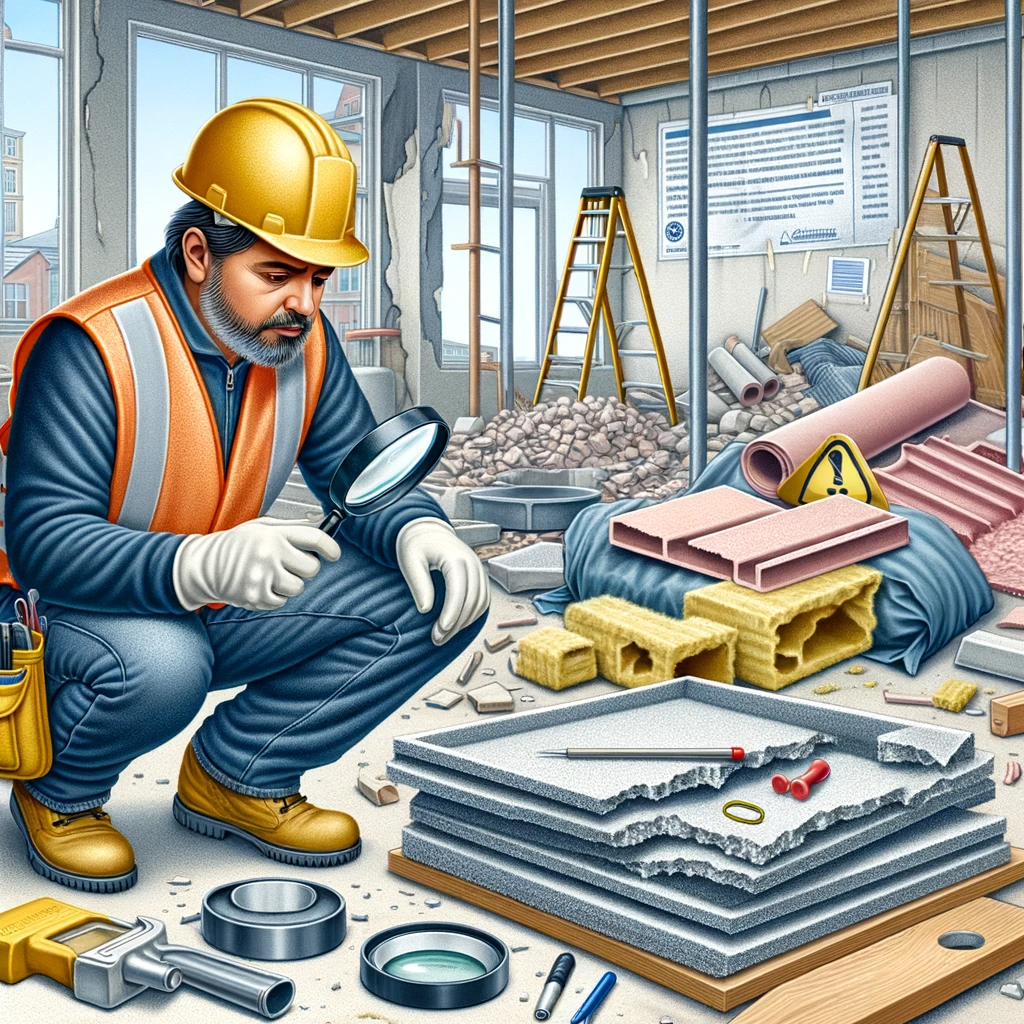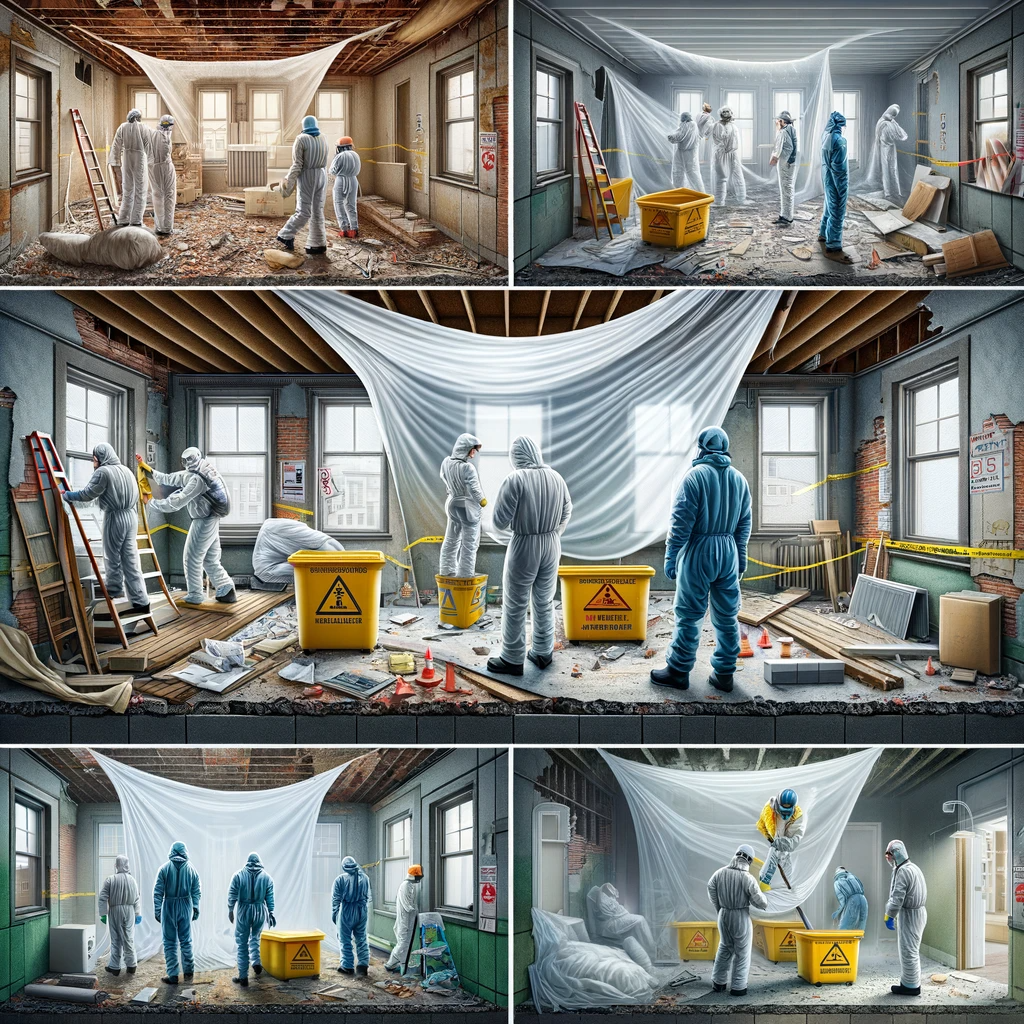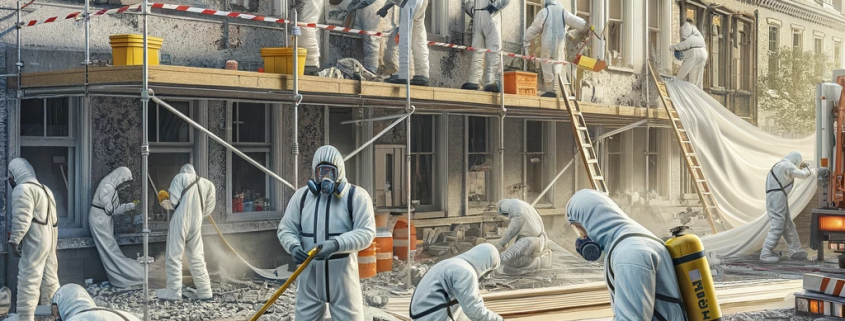7 Key questions on asbestos removal
Asbestos, once a widely used material in the construction industry, is now known for its harmful effects on health. The safe handling of asbestos-containing materials is therefore an issue of the utmost importance. This article addresses the seven most important issues surrounding asbestos removal. From identifying asbestos in buildings, to assessing the risk of undisturbed asbestos, to selecting qualified abatement contractors, this information is crucial for anyone handling or affected by asbestos.
1. how do you recognize whether a building contains asbestos?
Identifying asbestos in buildings is a complex process that is critical due to the health risks associated with asbestos. Asbestos was used in many building materials until the late 1990s due to its fire protection and insulation properties. Here is more detailed information:
- History and useAsbestos was commonly used in buildings constructed before the 1980s. Common asbestos-containing materials include flooring, roof shingles, pipe insulation, window putty, joint compounds and certain types of plaster and paint.
- Inspection by expertsAn asbestos inspection should always be carried out by a certified professional. The process usually begins with a visual inspection to identify areas where asbestos may be present.
- Sampling and analysisSuspect materials are sampled and analyzed in the laboratory. This is usually done by Polarized Light Microscopy (PLM) or Transmission Electron Microscopy (TEM) to determine the presence of asbestos fibres.
- Health risksAsbestos is particularly dangerous when it is damaged and releases fibers that can be inhaled. These fibers can lead to serious health problems, including lung cancer, mesothelioma and asbestosis.
- Guidelines and regulationsMany countries have strict regulations on the handling and removal of asbestos. It is important that homeowners and building managers familiarize themselves with these regulations and comply with them.
- Measures after identificationIf asbestos is identified, remediation or encapsulation measures should be considered depending on the condition of the material and the likelihood of it being disturbed.
Identifying asbestos is a crucial step in minimizing health and safety risks. The involvement of experts and compliance with legal regulations are essential.

2. is asbestos harmless if it is not disturbed?
The risks associated with asbestos depend greatly on whether the material is disturbed or not. Here is some detailed information:
- Condition of the asbestosAsbestos that is firmly bound in a material and is in good condition generally poses less of a risk. Problems arise primarily when materials containing asbestos are damaged, worn or otherwise disturbed, as asbestos fibers can be released in such cases.
- Release of fibersAsbestos is particularly dangerous when the fibers become airborne and can be inhaled. This can happen during renovation, demolition or maintenance work where materials containing asbestos are damaged.
- Health risksInhaled asbestos fibers can become lodged in the lungs and lead to serious health problems, including asbestosis, lung cancer and mesothelioma, a rare form of cancer that affects the lining of the lungs, chest or abdomen.
- Risk assessmentRisk assessment by professionals may be necessary to determine the condition of the asbestos and whether removal or encapsulation is required. If the material is in good condition and will not be disturbed, it can be safely left in place.
- Long-term managementFor asbestos-containing materials that are in good condition and are not removed, it is important to implement a long-term management and monitoring program to ensure that the condition of the material does not deteriorate.
- Consulting by expertsIt is always advisable to seek professional advice on the identification and handling of asbestos to ensure a correct assessment of the risk.
Handling asbestos requires careful risk management, especially when it comes to deciding whether to remove the material or leave it in place. The health and safety of the occupants or users of the building should always be the top priority.
3. how does the asbestos removal process work?
The asbestos removal process is a strictly regulated procedure that is divided into several key steps:
- First inspection and testsThe process begins with a professional inspection of the building in question. Experts take samples of suspect materials, which are analyzed in the laboratory to confirm the presence of asbestos.
- Preparation of the work areaBefore the removal work begins, the affected area is sealed off. This includes switching off the ventilation systems to prevent the spread of asbestos fibers and putting up warning signs.
- Safety measures and personal protective equipment (PPE)Specialist personnel wear suitable protective equipment, including respirators and protective suits, to protect themselves from asbestos fibers.
- Removal processAsbestos-containing materials are usually wetted to minimize the release of fibers. The materials are carefully removed and safely packed in special containers or bags.
- Air purification and negative pressure systemsAir purification systems with HEPA filters are used throughout the process to ensure air quality and prevent the spread of asbestos fibers.
- Final inspection and cleaningAfter removal of the asbestos, a thorough cleaning of the area is carried out. An independent inspection is carried out to ensure that all Asbestos materials have been removed and there are no more fibers in the air.
- Professional disposalAsbestos-containing waste is disposed of at specially designated disposal sites that are authorized to handle hazardous materials.
- DocumentationAll steps of the removal process are documented, including proof of disposal, to ensure compliance with legal requirements.
Asbestos removal requires specialist skills and equipment to ensure that removal is carried out effectively and safely. It is important that all steps are carried out in accordance with applicable laws and regulations to protect the health and safety of all involved.

4. can I remove asbestos myself?
The possibility of removing asbestos yourself depends heavily on local regulations and the type of building:
- Legal provisionsAsbestos removal is strictly regulated in many countries and regions. In some areas, homeowners are allowed to remove asbestos themselves in an owner-occupied single-family home under certain conditions. However, special safety measures must often be observed and disposal must be carried out by a licensed company.
- Risks of self-removalSelf-removal of asbestos involves considerable risks. Without the right equipment and knowledge of safety procedures, there is a risk of asbestos fibers being released, which can lead to serious health problems.
- Importance of expertiseAsbestos removal requires expertise in the safe handling and disposal of the material. Professional asbestos removal companies have the necessary equipment and expertise to safely remove asbestos and minimize health risks.
- Recommendations for homeownersAlthough it may be legal to remove asbestos yourself in some cases, homeowners are generally advised to use professional contractors. They can carry out asbestos removal safely and in accordance with current regulations.
- Necessary safety precautionsIf you do decide to remove it yourself, it is essential to take the necessary safety precautions, such as wearing appropriate protective equipment and strictly following procedures to prevent the release of asbestos fibers.
It is important to inform yourself thoroughly in advance and, if you are unsure, to use the services of experts in order to avoid risks to health and safety.
5 How is asbestos recycled?
The recycling of asbestos is a relatively new development and involves special processes to convert asbestos into a non-hazardous form:
- Conventional recycling methodsThe most established methods for recycling asbestos involve heating asbestos-containing material in a sodium hydroxide solution at temperatures above 1,250 degrees Celsius. This thermal treatment breaks down the asbestos fibers and results in the production of non-hazardous glass that can be used in the production of ceramics and earthenware or as aggregate for roads and concrete.
- Alternative technologiesOther technologies include the use of microwave thermal treatments to convert asbestos into ceramic bricks or porcelain tiles, and high-speed milling processes that break down asbestos fibers into non-hazardous inert minerals.
- Volume reduction and utilizationThese recycling methods can reduce the volume of asbestos waste by 50% to 99.7%, depending on the type of product recycled. This volume reduction is beneficial for landfills and can reduce the cost of disposing of asbestos as prices are often based on volume.
- Advantages of recyclingRecycling transforms asbestos into a non-hazardous substance, providing long-term solutions for disposal. The end products of recycling can be used safely instead of being disposed of as hazardous waste.
- Accessibility and costsRecycling of asbestos is currently available in some regions, but can be more costly than traditional disposal. However, technologies are being developed to make it more accessible and cost-effective.
Recycling asbestos offers an innovative way of solving the problem of safely disposing of asbestos-containing materials by converting them into non-hazardous products that can be reused. However, these methods are not yet widespread and are often associated with higher costs.
6 What should be done during an asbestos inspection?
Asbestos inspection is a crucial step in assessing the presence and spread of asbestos in buildings. Here are the most important aspects of such an inspection:
- Appointment of a certified asbestos inspectorAsbestos inspections should always be carried out by a certified expert who has the necessary knowledge and equipment to safely identify asbestos.
- Visual inspectionThe first step is a thorough visual inspection of the building, especially of areas where asbestos-containing materials are suspected. This often includes outdated insulation, ceiling tiles, flooring and other building materials.
- SamplingThe inspector takes samples of materials that may contain asbestos. These samples are then analyzed in a laboratory to determine whether asbestos is present and in what quantity.
- Assessment of the conditionThe inspector assesses the condition of the asbestos-containing materials. Materials that are damaged or worn can pose a higher risk as they can release asbestos fibers into the air.
- Creation of a report: Upon completion of the inspection, the inspector will prepare a detailed report. This report contains information on the presence of asbestos, the condition of the materials and recommendations for further action, be it removal, encapsulation or regular monitoring.
- Recommendations for correctionBased on the results of the inspection, the inspector can make recommendations for the removal or encapsulation of the asbestos. This will depend on various factors, including the condition of the asbestos-containing materials and the potential risk to building occupants.
- Follow-up inspectionsAfter asbestos abatement or encapsulation has been completed, a follow-up inspection should be carried out to ensure that the measures have been successful and that no asbestos fibers are present.
Carrying out a professional asbestos inspection is crucial to ensure the safety of building occupants and to determine appropriate measures for handling or removing asbestos.
7 How do you find qualified asbestos removal companies?
Selecting a qualified asbestos abatement contractor is a critical step in ensuring safe and effective asbestos removal. Here are the key elements in the search and selection process:
- Certification and licensingVerify that the company and its employees have the required certifications and licenses for asbestos abatement. These requirements vary by region and country, and in many cases certification by environmental or health authorities is required.
- Experience and specializationChoose a company that has extensive experience in asbestos removal. Specialized companies have the necessary expertise and equipment to safely remove asbestos.
- References and ratingsFind out about other customers' experiences with the company. Positive references and reviews can be an indicator of the reliability and quality of the services.
- Compliance with safety standardsEnsure that the company adheres to strict safety protocols, including the use of personal protective equipment and compliance with asbestos disposal regulations.
- Detailed restructuring plan: A reputable company should be able to provide a detailed plan for the Asbestos removal which covers all steps of the process, including safety measures and disposal methods.
- Costs and offersGet quotes from different companies and compare the costs. Make sure that the quotes cover all aspects of the refurbishment.
- Communication and transparencyA good company is characterized by open communication and transparency. They should be able to answer all your questions and provide clear information about the process and any associated risks.
- Aftercare and reportingCheck whether the company offers aftercare services, such as follow-up inspections and reports on the work carried out and proof of disposal.
Choosing the right asbestos removal company is crucial to ensure the health and safety of all parties involved and to ensure that asbestos removal is carried out in accordance with legal requirements and best practice.



